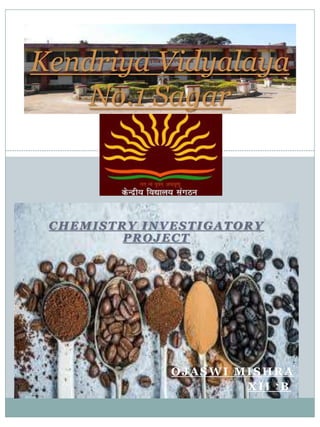
Chemistry investigating project
- 1. CHEMISTRY INVESTIGATORY PROJECT OJASWI MISHRA XII ‘B’ Kendriya Vidyalaya No.1 Sagar
- 3. Certification This is to certify that Ojaswi Mishra, a student of class XII-B, has completed research successfully on the project title “Determination of caffeine in different tea sample” under the guidance of Mr. S. S. Lodhi (subject teacher) during the year 2020-21 in partial fulfillment of chemistry practical examination conducted by AISSCE, New Delhi. Signature of examiner Signature of Signature of chemistry teacher Principal
- 4. Acknowledgement I would like to take this opportunity to thank my teacher, Mr. SS Lodhi whose support, guidance and encouragement have enable me to complete this project.
- 5. Aim Determination of caffeine in different tea sample.
- 7. Introduction Caffeine is a central nervous system and metabolic stimulant, and is used both recreationally and medically to reduce physical fatigue and to restore alertness when drowsiness occurs. It produces increased wakefulness, faster and clearer flow of thought, increased focus, and better general body coordination. The amount of caffeine needed to produce effects varies from person to person, depending on body size and degree of tolerance. Effects begin less than an hour after consumption, and a moderate dose usually wears off in about five hours. Caffeine has a number of effects on sleep, but does not affect all people in the same way. It improves performance during sleep deprivation
- 8. but may lead to subsequent insomnia. In shift workers it leads to fewer mistakes caused by tiredness. In athletics, moderate doses of caffeine can improve sprint, endurance, and team sports performance, but the improvements are usually not very large. Some evidence suggests that coffee does not produce the ergogenic effects observed in other caffeine sources. High doses of caffeine, however, can impair athletic performance by interfering with coordination. There is also evidence that caffeine may be helpful at high altitude. Caffeine constitutes about 3% of tea's dry weight. Tea also contains small amounts of theobromine and theophylline, which are stimulants and xanthines similar to caffeine.
- 10. Theory The most important methylated alkaloid that occurs naturally is caffeine. Its molecular formula is CsH10N4O2. Its IUPAC name is 1, 3, 7-trimethylxanthene and common name is 1- methylated thiobromine. Purely it is white, crystalline solid in the form of needles. Its melting point is 1230c. It is the main active principle component of tea leaves. It is present in tea leaves up to 3% and can be extracted by first boiling the tea leaves with water which dissolves many glycoside compounds in addition to caffeine. The clear solution is then treated with lead acetate to precipitate the glycoside compounds in the form of lead complex. The clear filtrate is then extracted
- 11. with extracts caffeine because it is more soluble in it then water. Effects of caffeine: Positive effects Acetylcholine is associated with attention, concentration, learning, and memory but there is no conclusive evidence yet that caffeine has any effect on memory and cognitive function. Low doses of caffeine show increased alertness and decreased fatigue. Caffeine has been shown to increase the metabolic rate. Negative effects Caffeine can increase blood pressure in non-habitual consumers.
- 12. High blood pressure is associated with an increase in strokes, and cerebral vascular disease, which in turn increase the risk of multi-infarct dementia. Caffeine may reduce control of fine motor movements (e.g. producing shaky hands) Caffeine can increase cortisol secretion, some tolerance is developed. Caffeine can contribute to increased insomnia and sleep latency. Caffeine withdrawal can produce headache, fatigue and decreased alertness. High doses of caffeine (300 mg or higher) can cause anxiety. High caffeine consumption accelerates bone loss at the spine in elderly postmenopausal women.
- 13. Apparatus Green label tea, yelow label tea, red label tea, lead acetate, glass rod, filter paper, funnel, water
- 15. Procedure First of all, 50 grams of tea leaves were taken as sample and 150 ml of water was added to it in a beaker. Then the beaker was heated up to extreme boiling. The solution was filtered and lead acetate was added to the filtrater, leading to the formation of a curdy brown coloured precipitate. We kept on adding lead acetate till no more precipitate has been formed. Again solution was filtered. Now the filtrate so obtained was heated until it had become 50 ml. Then the solution left was allowed to cool.
- 16. After that, 20 ml. of chloroform was added to it. Soon after, two layers appeared in the separating funnel. We separated the lower layer. The solution then exposed to atmosphere in order to allow chloroform to get evaporated. The residue left behind was caffeine. Then we weighed it and recorded the observations. Similar procedure was performed with different samples of tealeaves and quantity of caffeine was observed in them.
- 18. Observations 1. Red Label Tea (Brooke Bond) Weight of china dish - 46.60gms Weight of china dish with precipitate - 47.20gms. Amount of caffeine - 0.60gms 2. Yellow Label Tea (Lipton) Weight of china dish - 46.60gms Weight of china dish with precipitate - 47.15gms. Amount of caffeine - 0.55gms 3. Green Label Tea (Lipton) Weight of china dish - 46.60gms. Weight of china dish with precipitate - 47.05gms. Amount of caffeine - 0.45gms.
- 19. Conclusion Order of quantities of caffeine in different samples of tea leaves: Red label tea> Yellow label tea> Green label tea 600mg 550mg 450mg Red label tea Yellow label tea Green label tea
- 20. Bibliography •Help with teacher. •Help with parents and elders. •Help from library. •Help from internet.